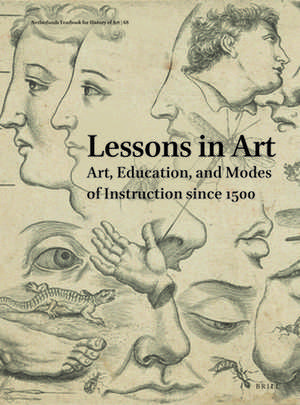Netherlands Yearbook for History of Art / Nederlands Kunsthistorisch Jaarboek 68 (2018): Lessons in Art. Art, Education, and Modes of Instruction since 1500: Netherlands Yearbook for History of Art / Nederlands Kunsthistorisch Jaarboek, cartea 68
Eric Jorink, Ann-Sophie Lehmann, Bart Ramakersen Limba Engleză Hardback – 25 sep 2019
Table of Contents
1.Ann-Sophie Lehmann & Bart Ramakers, Introduction
2.Caecilie Weissert, Clément Perret’s Exercitatio alphabetica (1569). A calligraphic textbook and sample book on eloquence
3.Koen Jonckheere, Aertsen, Rubens and the questye in early modern painting
4.Edward H. Wouk, From Lambert Lombard to Aby Warburg. Pathosformel as grammar
5.Bart Ramakers, Paper, paint, and metal foil. How to costume a tyrant in late sixteenth century Holland
6.Ann-Sophie Lehmann, An alphabet of colours. Valcooch’s Rules and the emergence of sense-based learning around 1600
7.Jenny Boulboullé, Drawn up by a learned physician from the mouths of artisans. The Mayerne manuscript revisited
8.Erin Travers, Jacob van der Gracht’s Anatomie for artists
9.Jaya Remond, ‘Draw everything that exists in the world’. ’t Light der Teken en Schilderkonst and the shaping of art education in early modern northern Europe
10.Joost Keizer, Rembrandt’s nature. The ethics of teaching style in the Dutch Republic
11.Erin Downey, Learning in Netherlandish workshops in seventeenth-century Rome
12.Annemarie Kok, Do it yourself! Lessons in participation in a dynamic labyrinth in the Stedelijk Museum Amsterdam
Preț: 619.07 lei
Preț vechi: 754.96 lei
-18% Nou
Puncte Express: 929
Preț estimativ în valută:
118.46€ • 129.08$ • 99.82£
118.46€ • 129.08$ • 99.82£
Carte indisponibilă temporar
Doresc să fiu notificat când acest titlu va fi disponibil:
Se trimite...
Preluare comenzi: 021 569.72.76
Specificații
ISBN-13: 9789004396739
ISBN-10: 900439673X
Dimensiuni: 193 x 260 mm
Greutate: 1.54 kg
Editura: Brill
Colecția Brill
Seria Netherlands Yearbook for History of Art / Nederlands Kunsthistorisch Jaarboek
ISBN-10: 900439673X
Dimensiuni: 193 x 260 mm
Greutate: 1.54 kg
Editura: Brill
Colecția Brill
Seria Netherlands Yearbook for History of Art / Nederlands Kunsthistorisch Jaarboek
Notă biografică
Eric Jorink, PhD., is Teylers professor at Leiden University and researcher at the Huygens Institute (KNAW). He is the author of Reading the Book of Nature in the Dutch Golden Age, 1575-1715.
Ann-Sophie Lehmann, Ph.D., University of Groningen, is Professor of Art History & Material Culture. She has published widely on the role of materials and making in the visual arts.
Bart Ramakers, Ph.D., University of Groningen, is Professor of Historical Dutch Literature and is an expert of Dutch literature up to c. 1800, especially of the Medieval Period and the Rhetoricians.
Ann-Sophie Lehmann, Ph.D., University of Groningen, is Professor of Art History & Material Culture. She has published widely on the role of materials and making in the visual arts.
Bart Ramakers, Ph.D., University of Groningen, is Professor of Historical Dutch Literature and is an expert of Dutch literature up to c. 1800, especially of the Medieval Period and the Rhetoricians.
Cuprins
Table of Contents
1.Ann-Sophie Lehmann & Bart Ramakers, Introduction
2.Caecilie Weissert, Clément Perret’s Exercitatio alphabetica (1569). A calligraphic textbook and sample book on eloquence
3.Koen Jonckheere, Aertsen, Rubens and the questye in early modern painting
4.Edward H. Wouk, From Lambert Lombard to Aby Warburg. Pathosformel as grammar
5.Bart Ramakers, Paper, paint, and metal foil. How to costume a tyrant in late sixteenth century Holland
6.Ann-Sophie Lehmann, An alphabet of colours. Valcooch’s Rules and the emergence of sense-based learning around 1600
7.Jenny Boulboullé, Drawn up by a learned physician from the mouths of artisans. The Mayerne manuscript revisited
8.Erin Travers, Jacob van der Gracht’s Anatomie for artists
9.Jaya Remond, ‘Draw everything that exists in the world’. ’t Light der Teken en Schilderkonst and the shaping of art education in early modern northern Europe
10.Joost Keizer, Rembrandt’s nature. The ethics of teaching style in the Dutch Republic
11.Erin Downey, Learning in Netherlandish workshops in seventeenth-century Rome
12.Annemarie Kok, Do it yourself! Lessons in participation in a dynamic labyrinth in the Stedelijk Museum Amsterdam
1.Ann-Sophie Lehmann & Bart Ramakers, Introduction
2.Caecilie Weissert, Clément Perret’s Exercitatio alphabetica (1569). A calligraphic textbook and sample book on eloquence
3.Koen Jonckheere, Aertsen, Rubens and the questye in early modern painting
4.Edward H. Wouk, From Lambert Lombard to Aby Warburg. Pathosformel as grammar
5.Bart Ramakers, Paper, paint, and metal foil. How to costume a tyrant in late sixteenth century Holland
6.Ann-Sophie Lehmann, An alphabet of colours. Valcooch’s Rules and the emergence of sense-based learning around 1600
7.Jenny Boulboullé, Drawn up by a learned physician from the mouths of artisans. The Mayerne manuscript revisited
8.Erin Travers, Jacob van der Gracht’s Anatomie for artists
9.Jaya Remond, ‘Draw everything that exists in the world’. ’t Light der Teken en Schilderkonst and the shaping of art education in early modern northern Europe
10.Joost Keizer, Rembrandt’s nature. The ethics of teaching style in the Dutch Republic
11.Erin Downey, Learning in Netherlandish workshops in seventeenth-century Rome
12.Annemarie Kok, Do it yourself! Lessons in participation in a dynamic labyrinth in the Stedelijk Museum Amsterdam










